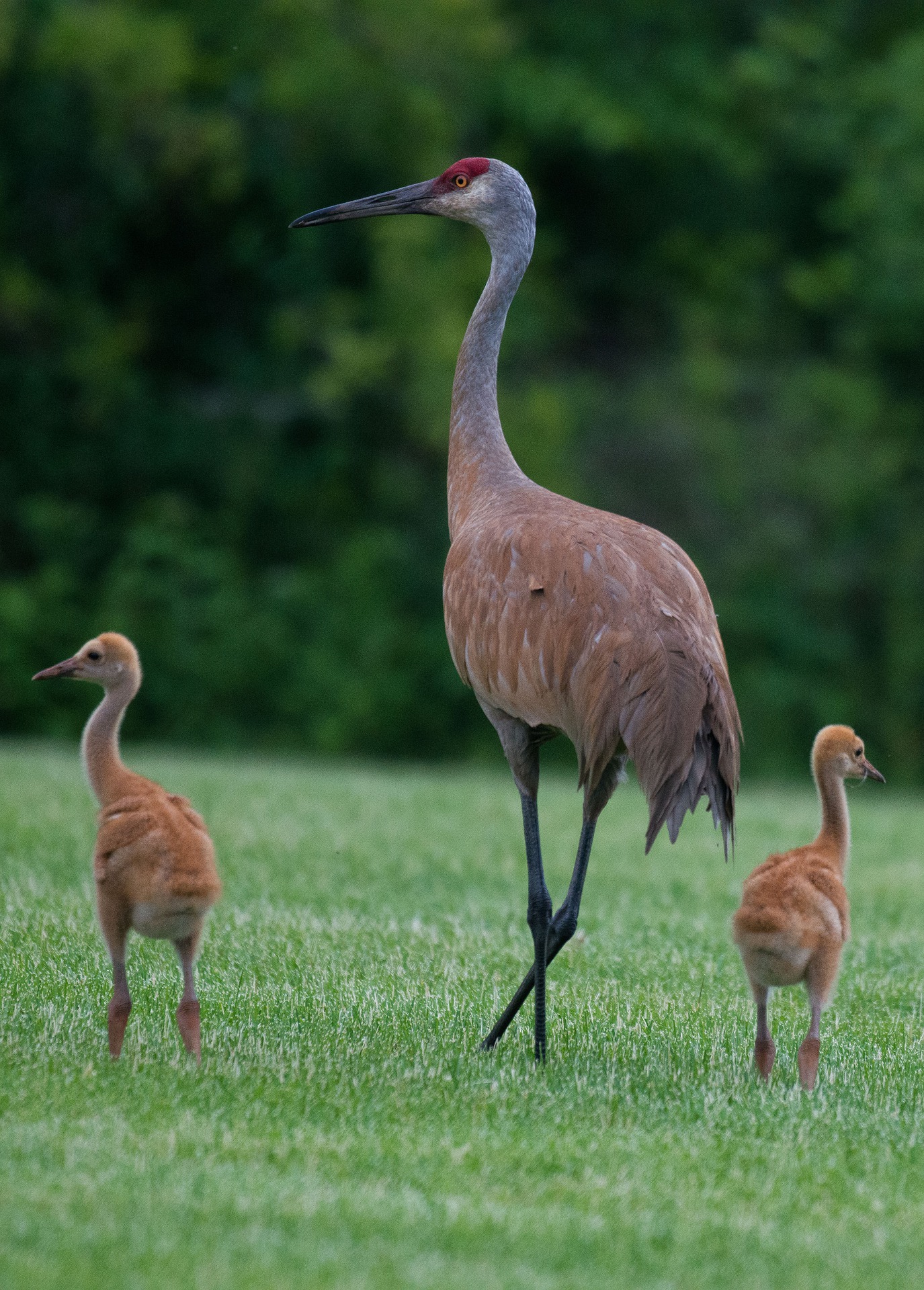The Sandhill Crane (Antigone canadensis)

The Sandhill Crane stands out among the crowd, quite literally in fact. This dashing wading bird is typically seen going for a dignified stroll with its mate in all areas of Florida. Its feathers are slate gray and its height typically ranges around four feet tall, but what really sets this bird apart is its striking red colored skin at the top of the head.
Heads Up!
Be aware of Florida Sandhill Cranes and their babies not only during the springtime, but throughout the winter! This wading bird frequents suburban areas. Their newborns typically hatch in the spring, but juvenile cranes stay with their parents for 9-10 months. Please keep an eye out for Sandhill Cranes and their young while driving!
Read on to learn more about this majestic crane species, or watch our Wild Sarasota Webinar: Herons and Cranes of Florida for a more in depth look.
Sandhill Cranes in America
Sandhill Cranes are a Florida favorite, and the love is reciprocated. There are six different subspecies of Sandhill Cranes found in North America: The Lesser Sandhill Crane, the Cuban Sandhill Crane, the Florida Sandhill Crane, the Mississippi Sandhill Crane, the Canadian Sandhill Crane, and the Greater Sandhill Crane. Three of these subspecies are migratory: The Greater, the Lesser, and the Canadian Sandhill Crane.
This wading bird is an extremely strong flyer, capable of flying 400 miles in a day. Many of these migratory Sandhill Cranes escape their harsh winters to come here, to Florida. In fact, approximately 25,000 Greater Sandhill Cranes cross the country to join our warm environment every winter. Our native Florida Sandhill Crane is a non-migratory species that enjoys our well-preserved ecosystems and comfortable climate enough to stay year-round.

One of a Kind
Aside from their bright red head, there are a few key characteristics that make the Sandhill Crane so unique and appreciated that the species has been celebrated throughout history. Yes, celebrated. There are around ten festivals dedicated to the Sandhill Crane hosted each year throughout the United States.

The Call
One of these unique characteristics include their distinct call sound. This unmistakable vocalization sounds almost like the quick burst of a trumpet, it is a loud and deeper pitch that seems to rattle out from their especially long windpipes. If you’re close enough, you can even hear this wading bird make a purr sound.
A Loyal Companion
Another special character trait of the Sandhill Crane is that they mate for life. What makes this species truly admirable is they remain monogamous and stay side by until death. Meaning it is quite likely to spot the Sandhill Crane in pairs, even their young follow them around for the first ten months of their life. Oh, and this is no short union; the Sandhill Crane lives longer than most birds, typically up to twenty years old. Two whole decades of marriage, a majority of the animal kingdom should be taking notes.
The Art of Dance
Last, but certainly not least, the Sandhill Crane is a dancer and performer. In a perfect combination of eloquence and flamboyance they bob their head and flaunt their six feet wings while simultaneously leaping high into the air with great energy. This beautiful dance can be used to express aggression but is most utilized to either find their mate or strengthen the bond between them. Which raises the question, is dance the secret to a healthy marriage in the animal kingdom?

To Learn More About These Majestic Cranes:
- Watch our Wild Sarasota Webinar: Herons & Cranes of Florida
- Check out the the UF/IFAS Wildlife of Florida Factsheets article on Sandhill Cranes.
- Read about the Sandhill Cranes profile at the Florida Fish and Wildlife Conservation Commission.
- Learn how to identify Sandhill Cranes at www.allaboutbirds.org
Read all our Wild Sarasota blogs HERE
 1
1
